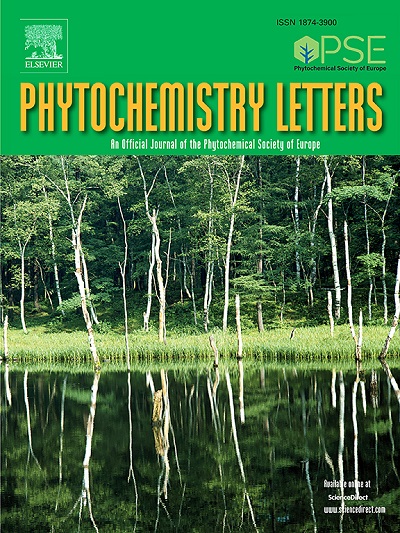菊花中的黄酮类化合物对黄嘌呤氧化酶的抑制活性:体外研究和硅学研究的启示
IF 1.3
4区 生物学
Q4 CHEMISTRY, MEDICINAL
引用次数: 0
摘要
从 Chrysanthemum morifolium Ramat.干花的乙酸乙酯馏分中分离出了一种新的黄酮类化合物--2-(3',4'-二羟基苯基)-3,6,7,8-四甲氧基-4H-色烯-4-酮(3)。4′,5-二羟基-3,3′,7,8-四甲氧基-黄酮(1)和可可碱(5),以及两种已知的黄酮类化合物--麦饭石酚-7-O-葡萄糖苷(2)和木犀草素(4)也是首次从这种植物中分离出来。利用色谱和光谱技术(核磁共振、傅立叶变换红外光谱、紫外光谱和 HR-ESI-MS)对它们的结构进行了广泛的研究。在分子对接分析中,化合物 4 对 XO 的抑制作用最强,与 XO 的相互作用也最有利。通过分子动力学分析,化合物 2、3 和 4 与黄嘌呤氧化酶中具有重要催化作用的残基发生了稳定的相互作用。本文章由计算机程序翻译,如有差异,请以英文原文为准。
Xanthine oxidase inhibitory activity by flavonoids from Chrysanthemum morifolium: in vitro and in silico insights
2-(3’,4’-dihydroxyphenyl)-3,6,7,8-tetramethoxy-4H-chromen-4-one (3), a new flavonoid was isolated from the ethyl acetate fraction of Chrysanthemum morifolium Ramat. dried flowers, while 4′,5-dihydroxy-3,3′,7,8-tetramethoxy-flavone (1) and casticine (5) were isolated from this plant for the first time, as well as two known flavonoids, eriodictyol-7-O-glucoside (2) and luteolin (4). Their structures were investigated over a broad spatial scale using chromatographic and spectroscopic techniques (NMR, FTIR, UV and HR-ESI-MS). Compound 4 showed the highest XO inhibition and the most favorable interaction with XO in molecular docking analysis. Compound 2, 3 and 4 demonstrated stable interactions with catalytically important residues in xanthine oxidase via molecular dynamic analysis.
求助全文
通过发布文献求助,成功后即可免费获取论文全文。
去求助
来源期刊

Phytochemistry Letters
生物-生化与分子生物学
CiteScore
3.00
自引率
11.80%
发文量
190
审稿时长
34 days
期刊介绍:
Phytochemistry Letters invites rapid communications on all aspects of natural product research including:
• Structural elucidation of natural products
• Analytical evaluation of herbal medicines
• Clinical efficacy, safety and pharmacovigilance of herbal medicines
• Natural product biosynthesis
• Natural product synthesis and chemical modification
• Natural product metabolism
• Chemical ecology
• Biotechnology
• Bioassay-guided isolation
• Pharmacognosy
• Pharmacology of natural products
• Metabolomics
• Ethnobotany and traditional usage
• Genetics of natural products
Manuscripts that detail the isolation of just one new compound are not substantial enough to be sent out of review and are out of scope. Furthermore, where pharmacology has been performed on one new compound to increase the amount of novel data, the pharmacology must be substantial and/or related to the medicinal use of the producing organism.
 求助内容:
求助内容: 应助结果提醒方式:
应助结果提醒方式:


